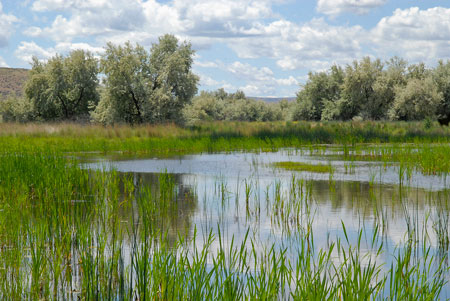By Michelle Werts

Earlier this week, the U.S. Department of Agriculture (USDA) announced that it’s helped restore more than 2.6 million acres of wetlands habitat in the U.S. through its Wetlands Reserve Program (WRP)! The program began 20 years ago as a way to bring people together to protect, restore and enhance wetlands on private and tribal lands. With 75 percent of wetlands located on private land, getting landowners to participate in this voluntary program has been a key part of the program’s success. And more than 11,000 have, helping reduce flood damage and aiding groundwater recharging and carbon sequestration.
As Jason Weller, acting chief of the USDA’s Natural Resources Conservation Service (NRCS), which administers the WRP, states in a news release on the program, “The Wetlands Reserve Program is a great conservation tool, providing landowners a way to protect and restore wetland areas while making improvements to their properties — it is a win-win for the environment, the landowner and the community.”
In Red River County, Texas, American Forests joined the NRCS’ WRP efforts with a multi-year project designed to restore native hardwood trees to a two-mile section of an alluvial floodplain along the Red River. The Global ReLeaf project helped plant more than 200,000 trees to convert the former agricultural land back to wetland.

The WRP isn’t the only NRCS program, though, that American Forests has helped support over the years. Global ReLeaf conducted a multi-year project in Alaska to restore timber lands across 2,600 acres through NRCS’ Environmental Quality Incentives Program (EQIP), which is another voluntary program aimed at providing assistance for agricultural landowners. We’ve also conducted multiple projects alongside the NRCS in Maryland to restore wetlands for the benefit of the Chesapeake Bay watershed.
Then, there are the countless other wetland projects we’ve conducted over the years with the U.S. Fish and Wildlife Service to help establish healthy wildlife habitat, such as our multi-year project in Virginia’s Great Dismal Swamp National Wildlife Refuge to create habitat for the black bear and other species. There are also the projects alongside nonprofit partners to restore wetlands and … yeah, we love wetlands.
You know what we love just as much as wetlands? Cooperative efforts to restore and protect the environment. One of the great things about the WRP’s success is that it was not built by one person or one entity alone. It was a collective effort between landowners, government, nonprofits and other partners. That’s what we love to see: People joining together for a common goal.